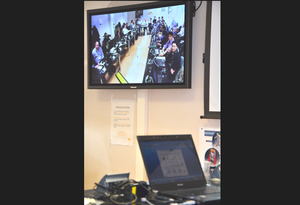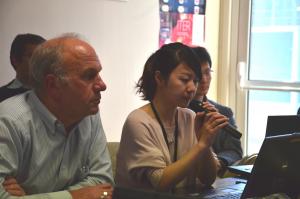Bringing the voltage down
2 Mar 2012
-
Jeremy Goff, Coil Power Supply Section
The workshop, hosted by ITER's Electrical Engineering Division's Coil Power Supply Section, reunited more than 40 participants.
High-voltage current from the French grid will be delivered to ITER's door by the tall pylons that descend, arms outstretched, from the hills of the CEA Cadarache research facility.
ITER's coil power supply system will convert the 400 kV grid voltage from these lines into controlled direct current in ITER's 22 magnet coils. The high voltage must be transformed down to a much lower voltage so it can be rectified and delivered at very high current through a huge busbar system to the magnet feeders.
A joint workshop was held at ITER from 27-28 February to discuss the instrumentation and control (I&C) for the coil power supply system; it was the first multilateral face-to-face meeting on this topic with all procurement stakeholders present: the Domestic Agencies from China, Korea and Russia and their suppliers, and ITER experts from the CODAC and Electrical Engineering Divisions—more than 40 participants in all.
The I&C system's role will be to configure the plant and allow it to be driven by the plasma control system to produce and maintain a plasma discharge. The system will also monitor and protect the plant and interconnect to the central interlock system, as well as protect personnel and the toroidal field coils from safety hazards by interconnection with the central safety system. The coil power supply system has many other interfaces, for example the pulsed power electrical network and cooling water systems.
Coordinator Jeremy Goff with Wu Yao from the Chinese supplier of the reactive power compensation system, Rongxin Power Electronic Co Ltd (RXPE).
The coordinator of this week's workshop, Jeremy Goff, likens the coil power supply system to the heart of ITER, pumping "lifeblood" through the ITER coils. "If the current does not flow there can be no plasma. The coil power supply system will be a huge installation and it must be very reliable. Some plant components will run continuously for weeks at a time ..."
Although the procurement for the system is shared, providing the coordinating "top layer" of the I&C system—the master control system—is the responsibility of Korean Domestic Agency.
The workshop met most of its aims: it brought together all those involved around one table, design proposals were shared, and further work identified to bring all the systems together into one. The participation of CODAC experts was highly beneficial and the next steps towards a common final design can now be taken.



